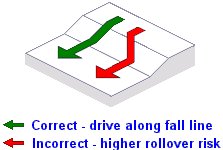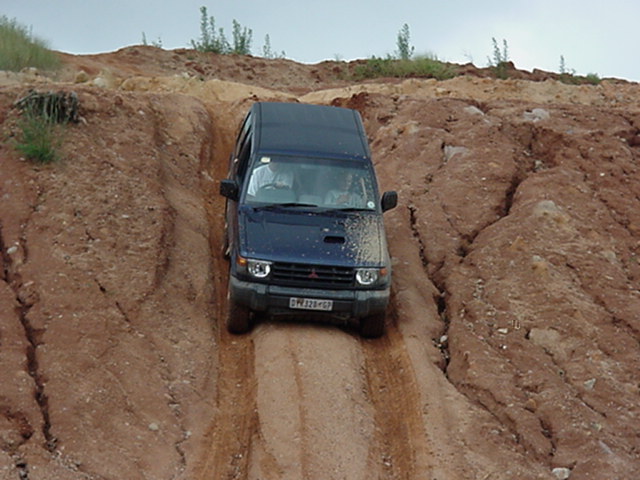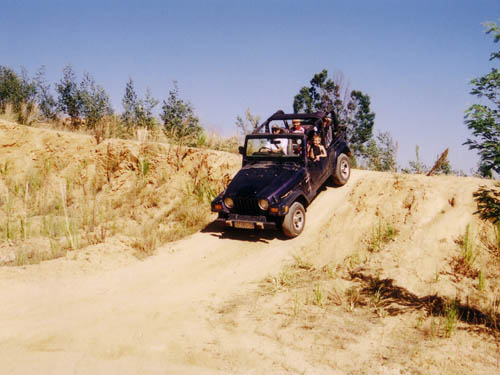|
|
 |
 |
 |
Off-Road Driving Techniques
Descending Steep Slopes
|
|
When you use your foot-brake on a steep slope to slow your descent, you
risk locking your wheels, resulting in skidding or sliding down, instead of
driving down. To make matters worse, when your wheels are locked and the
vehicle is moving, you loose directional capability, i.e. turning the steering
wheel will have no effect at all. The vehicle merely continues sliding downwards
along the fall-line of the slope.
|
|
 |
 |
|
The fall line is a term borrowed from snowboarding, and refers to the direct
way down a hill - the path that a ball rolls when you release it on a hill.
Never cross the fall line with your vehicle - you're risking a roll-over.
Always drive straight up or straight down.
|
 |
|
To counter these adverse braking effects, vehicles
equipped with
low
range gearing
use engine braking to regulate their
speed down steep slopes. Engage low range first gear,
remove your feet off the clutch and foot-brake, and simply
steer the vehicle straight down the hill. The engine's
torque will slow the vehicle sufficiently to allow you
to maintain control all the way down.
|
 |
|
Bear in mind that when driving down a steep slope,
you often cannot see where you're going until you're
actually on your way downhill. It's a good idea,
therefore, to stop your vehicle before the slope and
having a look on foot.
|
 |
|
Another interesting point to mention is ABS brakes. These work by sensing
when a wheel has locked. When a wheel is locked, the ABS system automatically
releases the brake and quickly re-applies it, to unlock the wheel. This
"automated" form of cadence braking is useful as ABS brakes can be used
on steep descents whereas normal brakes cannot.
|
 |
Regaining Directional Control
If you find yourself sliding out of control down a slope, regainging directional
(steering) control can be critical to bring your vehicle back on track, i.e.
directly onto the fall-line of the slope. To do this, go onto the accelerator
and steer the vehicle back to where you wish to go. Remember to always steer
towards the fall-line! Once done, go off the accelerator to allow the engine's
torque to slow you down again.
|
 |
 |
|
Exceptions to the Rule
While the techniques descibed above are more than
adequate for descending most slopes and inclines, you
will have times where this is just not feasable. A common
example is when rock-crawling (consider the Jeep in the
picture to the left). The rock you're driving down may
be very short, but very steep. Rocks also provide excellent
traction. In such situations it may be advantageous to use
the foot-brake all the way down, as you'd want to descend
slower even than engine braking allows.
|
 |
|
Ed. WTF? I don't see any rocks. D'you see rocks?
|
 |
Cadence Braking
Sometimes, when the slope is excessively steep, or the surface too loose,
the vehicle will slide, regardless of engine braking. In such situations,
rapidly apply the foot-brake to slow you down (even though the wheels will
lock up), and then quickly release the foot-brake and, if necessary, go onto
the accelerator to regain directional ability. Constantly repeat this process
all the way down the slope.
|
 |
Negative Torque
A parting thought. People use the term "negative torque" to describe the engine
braking effect mentioned above, where engine torque is high enough to slow down
a vehicle descending a slope.
Put simply, negative torque doesn't exist.
Think about screwing in a screw. Your hand turns the screwdriver, providing
the positive torque required to screw the screw in. Now, if you were to unscrew
that screw, you'd change the direction in which you're screwing, still producing
positive torque to unscrew the screw. Torque is an absolute - it can only be
positive. You can, however, change the amount of rotational force being applied
(by changing into a higher or lower gear), and its direction (by driving forwards
or backwards).
 |
|
BEWARE THE JARGON. It often does little more than obscure meaning and intent.
|
|
© 1995-2013 Martin Wittenburg and Michael Wittenburg. All rights reserved.
|